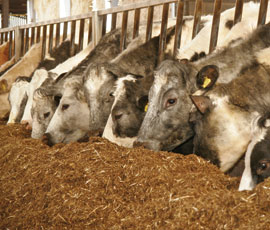Analyse, plan and secure your feed requirements

Livestock farmers are being encouraged to secure protein and energy feed requirements now to balance forage rather than wait until after the maize harvest.
A “mixed bag” of forage quantity and quality means many farmers will be forced to supplement forage with added energy and protein following a wet summer.
Dairy consultant Phil Clarke, of P and L Agriconsulting said many of his clients in Cheshire had a lot of low energy and low protein silage that needed propping up.
“A lot of people have had a large second cut of silage, but with low energy at 9.5ME and 11% protein, they need to spice it up. Products such as brewers’ grains that are good value for money and would buff out feed are in short supply, so you need to get your name on something now rather than wait until maize is in.
“Quite a lot of people may be relying on maize, but looking at many of the crops, they look at best average,” he said.
Mr Clarke encouraged farmers to analyse forage and assess how much they have and then look at the options available (see calculation examples above, right).
“Liquid feeds with high sugar levels can help give inert grass silage some life – such as liquid molasses with urea or bound urea. There’s also the opportunity for farmers to make the most of products coming out of biofuel plants and at the moment they look good value for money,” he said.
If farmers haven’t got a tank to store liquid feeds, Mr Clarke said tanks can be rented for as little as £200 for the winter or can be bought for £1,950 plus VAT (12t storage) with some companies allowing payments over 12 months.
Independent beef consultant David Hendy also urged farmers to focus on what forages they have got and to be “pragmatic” with what they can achieve with cattle.
“The big issue in England and Wales isn’t the quantity of forage but the quality. And the way beef and feed prices are, the sums may not add up,” he said.
Mr Hendy said beef finishers needed to think hard about whether the figures added up with protein and energy costs so high. “The finishing price may not be sufficient to justify the finishing ration,” he said.
Mr Hendy said he had been very busy consulting farmers across the country in what is usually his quietest month and advised others to get nutritional advice, if they hadn’t already done so.
“There’s no reason why rations can’t work well, as long as they are balanced. Nutritional advice will help you make the most out of what you have got.”
He also said liquid feeds looked favourable this year compared to vegetable protein
How forage is faring across the UK?
John Riley, Park Hall Farm, Cheshire – 260 dairy cows
“The poor weather will have cost us about £35,000 this year. We had used all our forage stocks in March and were expecting to graze good quality grass in June/July, but we had to bring the herd in.
“We had to buy 700t of grass silage, as well as extra straw and bedding.”
John Parry, Donington House Farm, Shropshire – 650 lowland mule ewes
“We should have plenty of forage this year and although we have yet to have it analysed the quality looks good. On all fields cut we got double the hay crop compared to last year.”
Iain Green, Corkse, Garmouth, Moray – 130 pedigree Simmentals, 330 Simmental-crosses, plus followers, 500 Highland Mule ewes and 340 sows
“We have been extremely lucky up in this neck of the woods as in the last six weeks alone we have had quite a bit of grass growth. Third cut silage will fill all the pits although we have yet to analyse them.”
Ian Fermor, Beddington Farm, Midhurst, West Sussex – 130 dairy cows and 150 beef cattle
“We should be OK for forage, we got a big first cut having just cut in time and we had a bit left over. Grass quality isn’t as good as previous years and the lupins we grow have suffered.”
| Conversion factors for silage volume to tonnes | |
|---|---|
| Silage dry matter | Conversion factor (tonnes of silage per m3) |
| Grass 20% | Multiply by 0.77 |
| Grass 25% | Multiply by 0.68 |
| Grass 30% | Multiply by 0.60 |
| Whole crop 40% | Multiply by 0.67 |
| Forage maize 30% | Multiply by 0.75 |
Worked exampleThe silage in a silo measures 28 metres long, 10 metres wide and 2.7 metres deep. Volume of silage = 28 x 10 x 2.7 = 756 cubic metres.This equates to 514 tonnes of 25 percent dry matter silage (756 x 0.68). Working out how much forage you have got (Calculations from Northern Ireland’s Department of Agriculture and Rural Development September management notes) | |
Estimated monthly feed requirement (25% DM silage) | |
|---|---|
| Class of stock | Silage (tonnes per month) |
| Dairy cows in milk | 1.4 |
| 200-250kg heifer | 0.6 |
| 350-400kg heifer | 0.9 |
| Dry suckler | 1.0 |
| Autumn calver | 1.2 |
